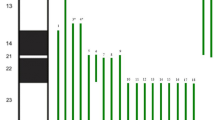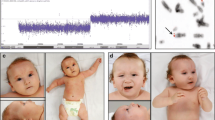Summary
This communication contributes an additional case of partial trisomy for the long arm of chromosome 4[46,XX,t(X;4)(q27;q25)]. Three generations of the patients's family were karyotyped and her mother and brother were found to be balanced translocation carriers. From the patient's clinical examination and from review of 13 similar cases reported in the literature, the following phenotype emerged: constant features were psychomotor retardation, muscle hypotonia at birth, undescended testes in all males and abnormal auricles, typically with a prominent antitragus. Anomalies of kidneys and other structures of the urinary system were present consistently as probably the most characteristic feature of the syndrome.
Over 200 structural anomalies of other systems were reported, many of them common to other autosomal chromosomal syndromes.
Similar content being viewed by others
References
De la Chapelle, A., Koivisto, M., Schröder, J.: Segregating reciprocal (4;21) (q21;q21) translocation with proposita trisomic for parts of 4q and 21. J. med. Genet. 10, 384–389 (1973)
Dutrillaux, B., Laurent, C., Forabosco, A., Noël B., Suerinc, E., Biemont, M.-C., Cotton, J. B.: Latrisomie 4q partielle. A propos de trois observations. Ann. Génét. 18, 21–27 (1975)
Fonatsch, Ch., Flatz, S. D., Hürter, P.: Partial trisomy 4 q and partial monosomy 18 q as a consequence of a parental balanced translocation t(4q-;18q+). Humangenetik 25, 227–233 (1974)
Francke, U.: Quinacrine mustard fluorescence of human chromosome: characterization of unusual translocations. Amer. J. hum. Genet. 24, 189–213 (1972)
Hamerton, J. L.: Human cytogenetics, Vol. I, pp 265–267. New York-London: Academic Press 1971
Paris Conference (1971): Standardization in human cytogenetics. Birth Defects 8 (7) (1972)
Schrott, H. G., Sakaguchi, S., Francke, U., Luzzatti, L., Fialkow, P. J.: Translocation t(4q-;13q+), in three generations resulting in partial trisomy of the long arm of chromosome 4 in the fourth generation. J. med. Genet. 11, 201–205 (1974)
Schwingshackl, A., Ganner, E.: Partielle B-Trisomie bei Cri du Chat Syndrom. Pädiat. Pädol. 8, 362–371 (1973)
Seabright, M.: A rapid banding technique for human chromosomes. Lancet 1971 II, 971–972
Shaw, M. W., Cohen, M. M., Hildebrandt, H. M.: A familial 4/5 reciprocal translocation resulting in partial trisomy B. Amer. J. hum. Genet. 17, 54–70 (1965)
Sparkes, R. S., Francke, U.: Syndrome of mental retardation and multiple congenital defects with partial trisomy of the long arms of chromosome 4 due to an inherited 20q+ translocation. Amer. J. hum. Genet. 25, 73A (1973)
Sumner, A. T.: A simple technique for demonstrating centromeric heterochromatin. Exp. Cell Res. 75, 304–306 (1972)
Surana, R. B., Conen, P. E.: Partial trisomy 4 resulting from a 4/18 reciprocal translocation. Ann. Génét. 15, 191–194 (1972)
Vogel, W., Siebers, J. W., Gunkel, J., et al.: Uneinheitlicher Phänotyp bei Partialtrisomie 4q. Humangenetik 28, 103–112 (1975)
Warren, R. J., Monkus, E., Tamer, A.: Partial trisomy of the long arm of chromosome 4. Amer. J. hum. Genet 25, 84A (1973)
Author information
Authors and Affiliations
Rights and permissions
About this article
Cite this article
Cervenka, J., Djavadi, G.R. & Gorlin, R.J. Partial trisomy 4q syndrome: Case report and review. Hum Genet 34, 1–7 (1976). https://doi.org/10.1007/BF00284426
Received:
Issue Date:
DOI: https://doi.org/10.1007/BF00284426




